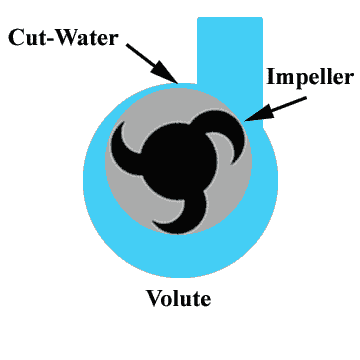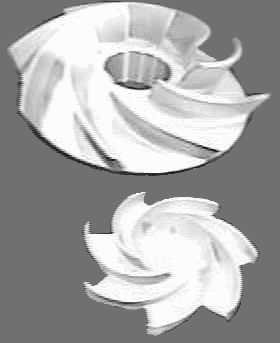
The centrifugal pump is by far the most widely used type in the chemical and petroleum industries. It will pump liquids with very wide ranging properties and suspensions with a high solids contents including, for example, cement slurries, and may be constructed from a wide range of corrosion resistant materials. The whole pump casing may be constructed from plastics such as polypropylene or it may be fitted with a corrosion resistant lining. Because it operates at high speed, it may be directly coupled to an electric motor and will give a high flow rate for its size.
In this type of pump, the fluid is fed to the center of the rotating impeller (eye of the impeller) and is thrown outward by centrifugal action. As a result of high speed of rotation the liquid acquires a high kinetic energy and the pressure difference between the suction and delivery sides arises from the conversion of kinetic energy into pressure energy.
The impeller consists of a series of curved vanes so shaped that the flow within the pump is as smooth as possible. The greater the number of vanes on the impeller, the greater is the control over the direction of motion of liquid and hence smaller are the losses due to turbulence and circulation between the vanes.
The liquid enters the casing of the pump, normally in an axial direction, and is picked up by the vanes of the impeller. In the simple type of centrifugal pump, the liquid discharges into a volute, a chamber of gradually increasing cross-section with a tangential outlet

The direction of rotation of impeller:

Various Impellers:

Centrifugal pumps are made in a wide range of materials, and in many cases the impeller and casing are covered with resistant material. Thus stainless steel, nickel, rubber, polypropylene, stoneware, and carbon are all used.
Last Modified on: 14-Sep-2014
Chemical Engineering Learning Resources - msubbu
e-mail: msubbu.in[AT]gmail.com
Web: http://www.msubbu.in